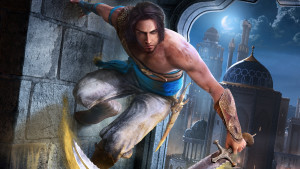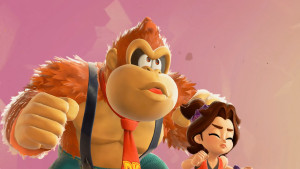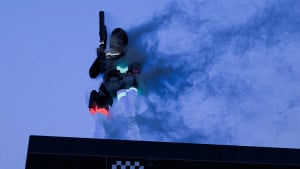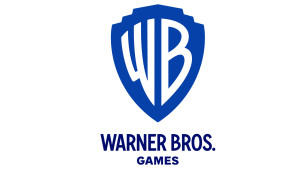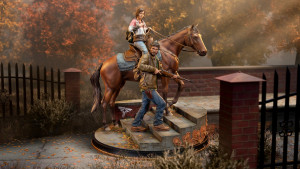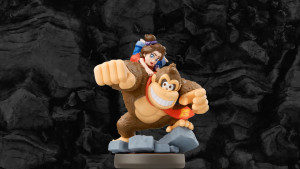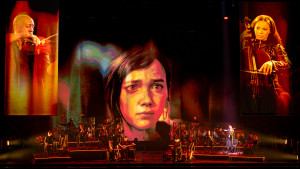The magazine is back. Get your subscription now!
Suriel Vazquez's 2017 Games Of The Year

2017 had dozens of great games, but I’m not sure where’d I’d place it on a ranking of gaming’s best years. Even with as many games as I can point to and say “this is probably good,” 2017 didn’t contain too many extraordinary or personally affecting ones for me. Although the top three games on this list landed with me in ways I wasn’t expecting, 2010, 2013, and 2015 all had several more games that I still look back at fondly for how they pushed the medium forward or excelled in some new way. That doesn’t meant this year’s games weren’t worth talking about, though.
There are lots of honorable mentions I don’t discuss here (Resident Evil 7, Gundam Versus, Gorogoa, Nidhogg 2, Gravity Rush 2, Prey), mostly because this list is already way too long. This list is 13 items long because 11-13 could have taken the #10 spot depending on when you asked me to lock it down, so I consider the first four games tied for tenth.
Anyway, here are the video games I enjoyed most this year.
13. Super Mario Odyssey
After being thoroughly blown away by the creativity of Super Mario Galaxy, the immaculate design of Super Mario Galaxy 2, and loving the heck of Super Mario 3D World, Super Mario Odyssey is a bit of disappoint for me. The fact that I still regularly added and removed it from my top 10 speaks to just how much I love 3D Mario games.
I did find a lot of what made those previous games so magical in Odyssey: The way its vibrant, colorful worlds create intricate and nuanced problems to solve, the way Cappy gives Mario’s moveset an incredible diversity, and just clowning around in these more open-ended levels is a blast.
But. By moving to a more exploration-based format, Odyssey trades a core part of what I like about 3D Mario games: A focus on tightly designed 3D levels that, while hiding a number of secrets, offer slithering but clear paths towards an enticing objective. I can certainly appreciate how well Odyssey’s more dioramic levels deviate from the norms of the series, but I don’t think the change is as alluring to me.
These worlds are relatively small to keep them dense, but I often felt like I ran out of new or interesting things to see in their main overworlds long before I’d found every Moon. So between Moons and purple coins (which are often hidden in obscure corners that don’t feel fun to suss out) I constantly felt like I was squeezing a sponge dry in order to find more Moons. The level-gating in the endgame is also a grind, and while your second trek through these worlds has some new surprises, I was still revisiting the same few levels for the sake of finding the umpteen corners that now have new Moons. Galaxy and Galaxy 2 also revisited levels, but because you always had a clear goal from the start, that repetition didn’t feel as labored.
Moons also feel like an unexciting reward because of how abundant they are. You’ll get Moons for anything from butt-stomping a mound of dirt that causes your controller to vibrate to conquering a truly challenging one-off level (which are often better than the worlds they’re hidden in). What’s more, the way you’re taught to pursue any tantalizing thread that might lead to a secret can backfire; I regularly thought of new tricks or areas that might lead to secrets I thought might reward me with a Moon, only to be disappointed (lighting all the street lights in the Cap Kingdom is a prime example). The reward structure a little unbalanced and random at times.
I don’t doubt that if I do go back and clean up the several hundred Moons I haven’t gotten, I’ll find more of the tight, creative level design I was craving. But I don’t want to wade through a sea of dirt mounds to find them. Odyssey almost made my top 10 list several times despite these qualms, and that’s mostly on the strength of the initial journey, where all of its Kingdoms feel new and exciting. But unlike Breath of the Wild, the gulf between the “abridged” and “expanded” experiences Nintendo likes crafting their games around is, in Odyssey, more of a hindrance than a way to take the game at your own pace. Still, those early hours are a joy, moreso than most of the games that came out this year.

12. Doki Doki Literature Club
What makes Doki Doki Literature Club special is wrapped up in spoilery details, and I’m going to discuss what makes it special. If you’d like to play the game before reading this (and you should), it takes about four to six hours and you can do it for free.
Literature Club subverts its visual novel structure in magnificent and terrifying ways. Like a good horror film, however, it needs time to establish what its norms are before breaking them. The initial 90 minutes are slow and tedious, as you meet the four main characters and endear yourself to one girl or another. It needs to take its time here, so that when it finally pulls the rug out from underneath you, you feel it. And although Sayuri was my least favorite character in the game, I had learned enough about her and had begun empathizing with her depression and performative happiness that the impact of seeing her dead eyes and head hanging from a rope in her room, accompanied by the boom of a close-up and computer error screen forced me to recoil in terror even though I saw it coming from a mile away.
From there, things only get weirder. As it becomes clear someone is tinkering with the game’s code, character portraits begin to glitch out, fall apart, and creep into unnerving territory. Bolded, misaligned text reveals the sinister, altered thoughts of characters you’re talking to, and by the latter half of the game, just going into menus made me a little anxious. The safety walls that give the player distance from fictional characters crumble in glorious ways, and the avenues developer Team Salvato uses within the limited framework of scrolling text and character portraits to make sure you never feel safe are impressive.
I don’t recoil much at spiders, monsters, or haunted houses, but something about the unnerving, glitched manipulation of characters got to me, which made my various playthroughs through Literature Club unbearable at times. I’ve never empathized with people who need to stop playing horror games until I decided to save my game and returned to a scare that likely couldn’t have happened otherwise.
More importantly, Literature Club’s scares are intertwined with its subject matter. Monika is ultimately a Mean Girl hacker, manipulating code to make sure you either become terrified or hate the other girls vying for your attention. She finds literal ways to exploit the fears and flaws of her classmates, amplifying them to expose the worst-case scenarios we tend to imagine when we reflect on our flaws. This thread is teased out judiciously until the end, and the creepy moments become tragedies in hindsight.
Unfortunately, as the scares start ramping up, I began to expecting mind-breaking moments that never came. And the limited scope of the visual novel means that it doesn’t have as many tricks up its sleeve as I would have liked. Still, Doki Doki Literature Club is one of the year’s biggest surprises, and it’s free, so should just play it.

11. Nier: Automata
Despite not cracking my top 10, Nier: Automata will stick with me for a while. The stories you find within its quiet world strive for something much different than most games. Where most video game quests offer a reward and resolution for your effort, Automata’s quests end with closure instead of satisfaction. See: The giant robot enemy who, after being defeated, realizes its role as a death machine and decides to atone by letting you end its life and dismantle it for parts. Or the society of warriors who huddle around a robot king they eventually realize won’t grow up and lead them to the utopia they imagined.
The end result is a series of stories that often left me wistful instead of powerful. Automata’s story is about the glimmers of hope we need to find amidst defeatism, and its world matches. Although invisible walls are everywhere most the environmental models look drab, low-res, and uninspiring, as a whole they’re lonesome, which I appreciated. I felt a sort of kinship with every character I found making their own way among the tattered remains of humanity through our mutual being stuck there. And as I got to know them, I found most of them had one tragedy or another up their sleeve. Finding a balance of different stories to tell this way without making them seem overwrought us tricky, but I think Automata finds it. I love this sad little world, and I won’t soon forget it.
This makes the ways it falls apart a bigger shame. Combat is boring, and while you might make the argument that it’s that way on purpose in order to make a point about the futility and banality of violence, I really do think it’s meant to be a fun, engaging aspect that simply isn’t. This has been a recent sticking point with me and Platinum’s action games: the combat is a little too button-mashy, and while combos are often flashy, I never felt much of think critically about most encounters, and wound up pushing whatever attack buttons I wanted as I waited for a chance to dodge.
What’s more, many quests later on pit you against enemies who have way more health than they should, leading to sluggish fights where you figure out the rhythms of a boss long before the fight is over and simply have to mash your way to victory for way too long. Many of them were often at higher level, but considering I only made it to level 45 by the end of the game, I’d rather have one drawn out fight than try to grind up to 60 to face a boss. And as much as I enjoyed the stories behind them, quests rarely require much more than running from one spot to another to ferry items between characters.
The main thrust of the plot also didn’t resonate with me as much as it has others. Maybe it’s because I’d already played Soma a couple years ago, but the way it handles the many topics it covers (the end and nature of humanity, the rebuilding of civilizations) didn’t seem particularly shocking or revelatory, and while the final playthrough is a triumphant bit of storytelling, it stands out for being poignant and subtle after hours of overeager pacing and hammy delivery.
Many of the plot points and side quests, on paper, sound like the more forward-looking Black Mirror episodes. Instead, the ways those plot points play out dampen much of the impact of their novelty, relegating them to fascinating but clunky tales. And while it may fit the plot, having 9S deride the robots around him as non-human for hours after it’s clear they clearly have some sort of sentience was grating.
Structurally, though, Automata is fascinating and, as with most other people this year Nier: Automata has definitely put creator and noted weirdo Yoko Taro on the map for me. As many problems as I have with Automata, the idea of this guy making another game, and maybe getting a bigger budget to do it, is exactly the kind of thing I want to hear.

10. Injustice 2
Netherrealm regularly builds fighting games like the blockbuster titles they deserve to be. Where most fighters still adhere to some sort of fondness to arcade standards, Injustice 2’s feels like a big-budget game that just happens to be a fighter. The foundation that big-budget flair is built around is solid, too, and the periphery aspects serve to enhance one of the year’s best fighting games.
As expected, Injustice 2’s story a fun fighting story mode where most others feel tacked on. It pays attention to character development, pacing, and cinematography in a way most other fighting game stories don’t. It isn’t a masterpiece of storytelling or even subtle, but it’s the fleeting character moments, like the wonderful interactions between Green Arrow and Black Canary, that give these characters more life than the cast of most fighting games, which helps to sell players on learning how to play each of these characters.
The Multiverse offers a fantastic loop that gives you a reason to return regularly to a game filled with things to do. Just having a reason to keep fighting AI opponents after you’re done with the story mode should be lauded, and the Multiverse works as both a thematic justification for fighting the same opponents over and over and an incentive to improve and tackle harder objectives.
These rewards wouldn’t work if the underlying fighting system wasn’t so solid, though, and while I bounced off the original Injustice’s formula, it’s clicked with me in a big way this time. Pre-built strings might be a little hard to work with for anyone who’s learned other fighting games, but they work because they make it easier to build combos and act as a buffer so you can disengage when you see the first few hits of your combo got blocked. The new ways you can spend meter also work to give most characters several new options in combat, and while there are still bad matchups, I never felt like there was nothing I could against most opponents. I’m also a sucker for juggle-centric combos, and Injustice 2 has those in spades.
When it first released, the loot system seemed like it would be a new way forward for people who want to enjoy fighting games but are afraid of competition. In hindsight, I don’t think the gear is implemented very well; you get too much of it, and after a while, most of it is scrap. Tying new moves to rare pieces of gear is a fun bit of experimentation, but ultimately doesn’t work for a number of reasons; most players want the illusion of being competitive, and the additional moves don’t work in a competitive format.
Overall, though, Injustice 2 is a fantastic fighter, one that offers something for everyone. It builds on NetherRealm’s strength in making fighting games appeal to new players, and the replayability it offers make me more excited than ever about the next Mortal Kombat game.

9. Pyre
Before release, I was all but convinced Pyre would break Supergiant’s streak of making it onto my top 10 list. Pivoting from voiceovers and action to text and sports didn’t seem to play to the strengths of the team based on their previous efforts. That preconception stuck with me for most of the year, until I realized I’d kick myself if I played it this year, loved it, and felt like I had committed a crime by not including it on this very prestigious list. And look what happened!
Pyre is easily Supergiant’s most ambitious game, and its bimodal narratives support each other. Each match of the three-on-three fantasy basketball is preceded by beautiful prose, narration, and lore, which gives each match a sense of purpose. The decisions you make as you trek across the oppressive world of the Downside influence not only which team you play next, but under what conditions; choosing to have a heart-to-heart with one of your teammates might make them stronger in the next match, but searching the area with another might yield a powerful talisman that could swing the next match in your favor. Whether you win each match in turn sets even more dialogue and character choices in motion.
Pyre also makes it easy to immerse yourself within its fascinating world. From the way jargon is defined through in-game hyperlinks instead of exposition, to the lore book that lets you learn more about the historic figures of the Commonwealth and Downside without slowing down the pace of the main plot, Pyre displays a clear love of the written word. Every character’s dialogue is written with a distinct voice, and between these interactions and the beautiful character portraits, you get a powerful mental image of a world you don’t see all that much of. Its characters are all shades of grey, with various motivations for joining your crew, opposing you, or being a part of the rites. Few games this year had as many characters whose motivations I could relate to in some way or another, and doing right by my party members presented a strong pull to change up my party constantly.
With the emphasis on text, I was a little worried the fantasy basketball wouldn’t hold up, but the more Pyre I played, the more I loved it. With party members of different sizes, speeds, and abilities, leveling traits that feel impactful, difficulty modifiers, and equippable items that all feel like they break the game in one way or another, there’s a lot to of ways to express your own playstyle, and the setup is simple enough to avoid overwhelming you. The combination of the stakes placed on each match and simplistic AI meant I didn’t want or have to experiment with new strategies, but later ones definitely tested my mettle, and I’m considering another run on a more punishing difficulty to see how a spottier season record might affect the story.
The second half drags a bit as you repeat matches against opponents, but the characters, world, and plot kept me so engaged it hardly mattered. I know Supergiant isn’t a studio that repeats itself, but I would absolutely love to see more of this world, whether that means another world or a novel.
8. Destiny 2
Across two platforms and four characters, I’ve spent 230 hours with Destiny 2. My relationship with it is fraught, triumphant, tedious, and great.
Besides a developer that can’t seem to exit a cycle of screwing up minor details, not communicating well, and apologizing for both of those offenses, I think Destiny 2’s problems lie with it being one game that has to appeal to many different audiences. The more I think on it, the more I think the campaign is both mediocre and deceptive. But it has to be there, because substantive single-player campaigns are how multiplayer games reach people outside of their normally insular audiences.
It also wouldn’t make sense to drop players right into the endgame, where Destiny 2 distinguishes itself as a shooter-MMO, and this is where its shooting makes sense. It doesn’t have the freeform physicality of Titanfall, but knowing when you use what gun, your character ability, and how to distinguish enemies from objectives are all key parts of the puzzles strikes and raids present you, which are more in line with MMO tropes than they are shooter ones. That emphasis on on-the-fly puzzle solving over pure twitch skills is what lets most people who love cooperative games get wrapped up in the endgame treadmill. And even with Nintendo’s foray in HD Rumble this year, I still think Bungie is the master of giving your actions weight through the way your controller shakes.
The cooperative shooter at the heart of Destiny 2 is some of the most fun I’ve had with video games all year. While there aren’t nearly as many as I’d like to keep their rotation fresh, strikes are more active and fun than they were in the first Destiny, and do a better job of introducing mechanics in the raid while having bosses that aren’t just health sponges. I didn’t take too well to the timed rhythm of Nightfalls at first, but after getting used to their flow, I like the way they diverge from regular strikes. I’ve reached a good balance where they keep me on my toes while feeling like slipping into an old t-shirt.
Then you have the raids, which are some of the most dynamic and satisfying co-op experiences you can have on a console (and are no slouch on PC, either). Coordinating movement, shots, and strategies with five other people never plays out the same twice and act as a great counterweight to the static, demanding challenges at hand. Although they can be punishing in many ways, raids usually accommodate slight deviations that mean I’ve had to relearn encounters after realizing a new group approached a particular encounter differently. They’re the reason I still play Destiny, and although new gear is fun and all, the chance to tackle a new raid (or revisit an old one) is what I look forward to most with every game and expansion.
Destiny 2 has problems, and I know them well. Duplicate exotics are still rampant. The weekly milestone system means you have a limited window in which you’ll make real progress to hitting the gear cap. Getting new gear still feels too much like wringing a slot machine dry. Despite the 230 hours I’ve spent with Destiny 2 I think many of them weren’t well-spent for these reasons. But I can’t deny that I love this game, and it can only get better from here.

7. Assassin’s Creed Origins
There’s a lot to like in Assassin’s Creed Origins, and I’ve pointed out most of it in my review. Long story short: Origins is the game I’ve been waiting for since I finished Assassin’s Creed II.
While everyone was falling in love with Mass Effect last decade, I couldn’t get enough of the world and characters of Assassin’s Creed. After II, though, the promise of the modern-day story arc never really came to pass. Since then, the series has oscillated from truly bad (III) to good (Black Flag), but couldn’t shake the need to wrangle players into particular playstyles; I found most of the mission designs restricting and often punishing. Coupled with the optional objectives in later games (which rewarded even stricter playstyles), and I never felt the freedom to approach missions the way I wanted.
Origins swings back wildly the other way, giving players more tools and trusting them to make their own fun. Although the assassinations aren’t as bespoke or elaborate as they have been, I prefer tackling a fortress however I want, even if that means “breaking” the experience, than following a set of objectives that might offer a cooler setpiece moment.
Egypt trades the verticality of cities like London and Paris for more traditional open-world expanse, and I think that’s the biggest loss here. But I think it’s worth the trade, since with all the interesting side missions, collectibles, and breathtaking views, Egypt is a blast to explore. Bayek and Aya’s relationship is also so natural and eloquently depicted that it almost made me forget that the present-day stuff is still really bad.
Origins does feel like a bit of first draft. The mission design is perhaps a bit too loose without enough tools to make similarly-built fortresses fun to take down. But I prefer this new structure to the one the series felt bound to in the past, and I hope Ubisoft builds on it in substantial ways next time around.

6. For Honor
For Honor might be the most novel big-budget game that came out this year. Even though it’s made up of familiar pieces, the tense standoffs they produce, in which two combatants jockey their weapons around as they wait for an opening, feels like a refreshing fusion of fighting games and third-person action games that ends up feeling like neither.
I’ve already explained my admiration for the way For Honor’s combat adapts fighting game ideas into a more palatable form. But thinking back on it, the three-way blocking system makes so much sense, and is executed so well, that I’m surprised this isn’t the second entry in the series. It just works, and not only rewards high-level play, but is balanced in such a way that where no matter how little health you have, you feel like you can defeat anyone if you play and react well enough. Lopsided three-on-one fights are still difficult, but they’re not impossible, and that the combat system can accommodate for both types is impressive.
This is par for the course in a fighting game, but For Honor isn’t a traditional fighting game, and as an objective-based multiplayer game, the combination of small-scale fights and macro-level thinking makes Dominion a fascinating mode. It doesn’t always work and fleeing works a little too effectively, but I haven’t played too much like else like it.
I’ve gravitated toward the smaller scale modes like the two-on-two mode, where equipment doesn’t matter and it feels more like a fighting game. Here the class differences really shine, and figuring out the nuances of your character while reading those of your opponent’s reveals layers of depth you may not find in the more chaotic modes. And the more I play it, the more it reinforces how different For Honor really is from any other game out there.
There are problems, to be sure. The equipment system doesn’t work as well as it should, disconnects are still fairly common, and all the different modes could make it hard to keep a consistent player base. But for sheer novelty and great execution, For Honor was the best multiplayer game I played this year.

5. Yakuza 0
I wonder how longtime Yakuza fans feel about the way 0 has captivated an entirely new audience for the series. Are they turning their noses up at everyone who will inevitably think of it as the best game in the series when entry X is clearly the best one and these new fans just haven’t played it? Or is 0 truly among the best in the series?
Either way, Yakuza 0 is such an explosive mix of wacky hijinks, heartfelt characters, and soap-opera plot twists that I couldn’t put it down for a full week. It’s a variety show that manages to wrangle all of its disparate threads into a consistent whole surprisingly well. Quests where you’re trying to get a dominatrix to fulfill her potential by feeding her the cruelest and effective lines lands as well as a dramatic scene where Kiryu and Nishikiyama desperate try to find a way out of being murdered by their former clan. These sequences flow into each other without conflicting, emerging as natural (if outlandish) tales of everyday life. And if you don’t like the wacky stuff, you can skip most of it altogether. But you’d be missing out on some great moments.
And for all the outlandish moments and over-the-top combat, Yakuza manages to tell a relatively grounded tale about people dealing with human problems in the criminal underground. In a way, it’s the sort of gritty crime tale I’ve wanted Rockstar to deliver since Grand Theft Auto IV. People’s histories catch up to them whether they deserve it or not, and the way crime syndicates infect the people around them are captivating. The Yakuza also come off as sympathetic without making them seem like the secret good guys.
The brawler-style combat is Yakuza 0’s biggest weakness. It feels boring and tedious at times and frustrating at others, as a few of the bosses implement strategies and push you in ways random fights don’t prepare you for. And the multiple styles don’t feel like they add much to combat. I rarely felt up for a fight, but besides a few humps in the midgame when I accidentally equipped an item that made combat much harder, combat was more of a chore than a challenge or attraction.
I’m more than willing to put up with the combat, though, since Yakuza 0 is a fantastic game otherwise. Without having to flesh out some sort of fantasy world, its stories offer something you don’t get in to many other open-world games. I haven’t gotten around to Kiwami, but I’m glad that between it, Kiwami 2, and 6, there’s a whole lot of Yakuza to go around, because I’m willing to play as much Yakuza as I can.

4. Cuphead
After seeing Cuphead several times throughout the years, I was worried it would fall into the trap of being a gorgeous indie game without much substance behind its visuals. Making characters and bosses that looked that good and animated and played well sounded like an impossible task. Studio MDHR was more than up to it.
Cuphead’s side-scrolling gameplay not only holds up its end of the bargain, but becomes the crux of the entire experience, revealing its depth over the course of several hours without wearing out its welcome. The action feels nimble and precise, and I never found situations in which I was completely overwhelmed by a sea of bullets or an insurmountable obstacle. No matter how absurd the patterns are or how quickly an attack comes out of nowhere, you can always find a solution, and the more you play, the more you begin to realize that something you at first noted as a bunch of bullcrap really isn’t.
As you figure out which weapons (charge shot) and bonus abilities (smoke bomb) work best, bosses frequently challenge you to change them up, and the variations between run-and-gun and aerial battles benefit from different loadouts. This variety gives you another out to take a step back, reconsider your loadout, and approach a boss with a new perspective. I was able to find breakthroughs after humbling myself a bit and using the tracer rounds on certain phases of bosses, then switching back to the charge shot for others, and still get an A rank.
Speaking of which, I’m a sucker for ranks. Any game that can compel me to not just overcome a task, but ace it has a better shot of getting its hooks into me, and Cuphead does that superbly. Instead of dreading another run at a difficult boss, going back to a boss after you’ve beaten it for an A (or S) rank acts as another reason to play more Cuphead.
So while the art style is Cuphead’s main attraction, the action makes a far better case for itself than it has to. It’s brutal, but fair, and its delightful challenges are malleable through equipment, difficulties, and optional challenges. And no matter how tough the going got, I enjoyed the simple act of trying, which is the most you can ask of a game about repetition.

3. Night in the Woods
Night in the Woods feels like a wake-up call to anyone who writes video game dialogue. Its incredibly natural, casual writing more closely imitates the way people speak better than any game I’ve played. That natural dialogue goes a long way in a game about people talking all the time, and seeing a game that finally foregoes the formalities of written works for the sake of better characters is a triumph. More than anything in For Honor or even Breath of the Wild, it’s the trend I hope more games adopt going forward.
That incredible dialogue propels a story that’s also relatable and fun, but also poignant and thoughful. The stakes are relatively low but Mae, Gregg, and the rest of the cast have arcs and reveal their intricacies and ways that, again, don’t feel “written.” Mae isn’t a exemplar of morality, and her struggles to figure herself out with the help of her friends is the kind of down-to-earth storytelling I’d like to see in more games. In fact, the story is the least compelling when it’s tempted by the idea that something major has to happen. Better than the seedy main plot towards the end are the moments where it tackles topical subjects in nuanced ways, taking a stance on issues in a way most games don’t without turning the opposite side into villainous caricatures.
Exploring Mae’s hometown also shows the joy of getting to know the people around you. Although your reward is simply seeing more character moments or bits of story, the way each screen encourages you to poke around, talk to people, and see what’s going on around shows just how much work goes into games like this. “Walking simulators” aren’t just about building an environment and having you walk through as narration plays. There’s an artistry to the way certain parts of the environment catch your eye or pique your curiosity, and exploring in Night in the Woods always yields something worthwhile, whether it’s a fun little moment or another chance for personal reflection.
2. Wolfenstein II: The New Colossus
The New Colossus is an unrepentant, defiant middle finger of a game. As most game companies shied away from inciting too much negative attention, The New Colossus is unabashed about its stance that Nazis are bad people. That it can actually stand by this stance, tweak it with nuance without capitulating, and feature some of the pulpiest, zany moments of the year is kind of incredible.
From the early scenes aboard Eva’s Hammer to the final scene in the TV studio, every moment feels at once perfectly framed within the context of its characters and ridiculous world and built for maximum shock value. I regularly though that after watching one scene that I’d seen the craziest thing it had to offer only to be immediately be proven wrong in spectacular fashion.
As crazy as every moment is, the plot earns pretty much all of them through proper foreshadowing. Machine Games didn’t simply toss in shocker moments to rile you up. It’s making a statement: The crazy part isn’t that all of these crazy, unthinkable moments just keep happening - it’s that they were waiting to happen this entire time.
Among the pulp are somber moments that showcase how depressing Nazi-controlled American really is, and how frighteningly feasible it could be. BJ’s arc from steely determination to fatalism to renewed vigor gives him a depth most square-jawed shooter protagonists don’t have. The ensemble cast gets plenty of room to breathe, too, and the conflicts between members of your crew all carry interesting points to consider. Anger and sadness give way to gallows humor nestled in tiny pockets throughout the game, reinforcing the need for diversion during dire straits.
At the risk of sounding like an elitist jerk, I think the shooting is intense and fun, but only on a keyboard and mouse. With a controller, combat feels sluggish, and you need to move around constantly and lay into Nazis before they ever have a chance to hurt you. On PC this is more than possible, and laying into the more armored Nazis enemies with a pair of single-shot assault rifles by mashing my mouse several times feels cathartic.
BJ moves with a momentum that lets you embody his overwhelming powerhouse of a character. The screen bobs as you sprint and the rattle of your boots on the ground is loud, which gives moving around as BJ a physicality you don’t get in most shooters. Crashing into enemies and tearing them apart or sneaking up behind them and dismembering them with a hatchet are both equally satisfying. But unlike Doom, which emphasizes power fantasy, there’s a latent fear in these fights. If you’re not careful you can ripped up easily as any enemy, and my early fights, where I was still figuring out that you can’t set up shop behind cover and pop shots over it, were rough. But once I got used to it and let go of the trepidation most other shooters had instilled in me over the years and realized half-measure wouldn't cut it anymore, combat was a blast.
Wolfenstein was my biggest surprise of 2017. I was lukewarm on The New Order, but The New Colossus fires on all cylinders in a way few games do. Its plot is relentless, its characters are complex and conflicting, and yes, the combat is a furious delight. For 14 glorious hours this year, I was Nazi-murdering machine with a heart, and it was joyous.
1. The Legend of Zelda: Breath of the Wild
In recent years, I’ve come around the idea the many of Nintendo’s most prominent games get a boost simply from their brand names. It’s hard not to look at reviews for Skyward Sword and Twilight Princess and feel like everyone raving about Zelda is just crying wolf again. But Breath of the Wild isn’t just “good for a Zelda game.” It comes closest to fulfilling the promise of open-world games.
There’s lots of stuff hidden throughout many open-world games, but so many of them are too eager to tip their hand, pointing you toward every interesting collectible or side story. That Zelda doesn’t explicitly do this is a paradigm shift for two reasons. First, it means you feel a sense of reward for finding anything at all, making each discover personal. Filling out the map by scouting things yourself and jotting them down enhances the sense of progression you get from slowly building up your arsenal of weapons and items.
Second, it makes every part of the map equally interesting. Even the best open-world games feel less like an actual world to explore and more like collection of destinations you travel between because the interface emphasizes the ends (objective markers) over the means (the path you take to them). By not going for this approach, Breath of the Wild lets players value the journey. Sure, shrines are clearly displayed as the most important places you can visit most of the time, but often, the ways you get to them are as interesting (if not moreso) than the shrines themselves. This gives value to open spaces, and lets you linger on the plains and expanses of its beautiful world as much as the crowded areas filled with secrets.
When you think of it that way Breath of the Wild’s hardships come into focus. Because the trek is as important as the finish line, it makes sense for there to be obstacles in your way. The rigorous nature of climbing is an important part of traversal because climbing a mountain should feel like an achievement, not a throwaway obstacle on the way to the next objective. Rain makes climbing harder, but not impossible (time your hops and bring some climbing potions and gear and you can make it up any slope in the rain).
The end result exploration that’s just as important as all the challenges you find along the way, and that feels appropriate in a game about exploring a massive world. It feels truly open-ended in the sense that going in any direction is equally valid. In fact, I’d say the most directed parts of Breath of the Wild (the setpiece moments leading up to the dungeons and the dungeons themselves) are the least interesting parts. But otherwise, exploring one area for Korok Seeds and seeing what Eventide Island has to offer both feel as good of a use of your time.
There’s a lot more to say about Breath of the Wild. About the way this lack of direction interacts seamlessly with the way it layers a bunch of systems onto that exploration, rolls them all at once like dice, and lets the player see what happens. About how its post-apocalyptic world feels serene and quiet in a way Zelda usually isn’t.
And, yes, the weapons break. I can’t defend it much. But that feels like more of an academic criticism than a practical one: while I agree that it would better if you could keep a trusty steel companion at your side from the start, having to switch weapons constantly was never a huge concern for me in the 80+ hours I spent in Hyrule this year. I can acknowledge it as a weak point, but it didn’t impact me as much as it might have others.
Nintendo has fully broken out of its comfort zone this year, and Breath of the Wild is by far the best case for why it should keep doing that. It is not only a Zelda game worth raving about beyond the confines of Nintendo fandom, but an open-world game that truly carves its own path and, as a result, comes closest to giving us the “living, breathing world” we’ve been promised for so long.

